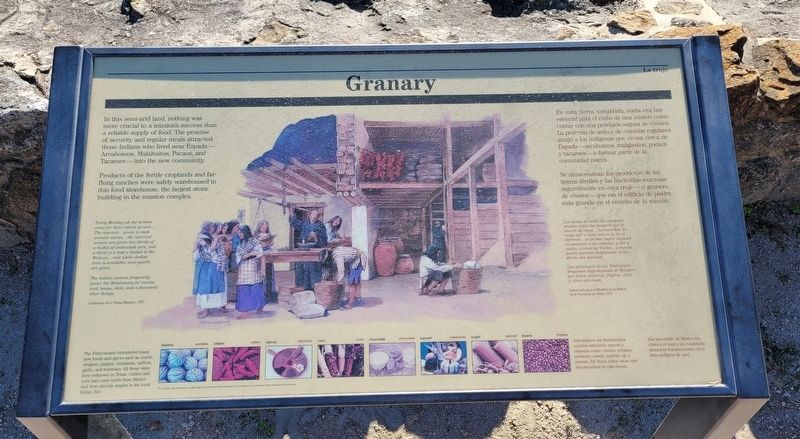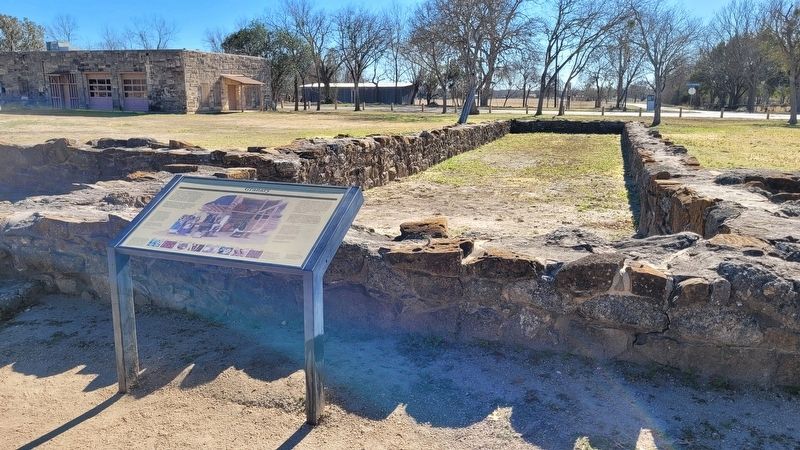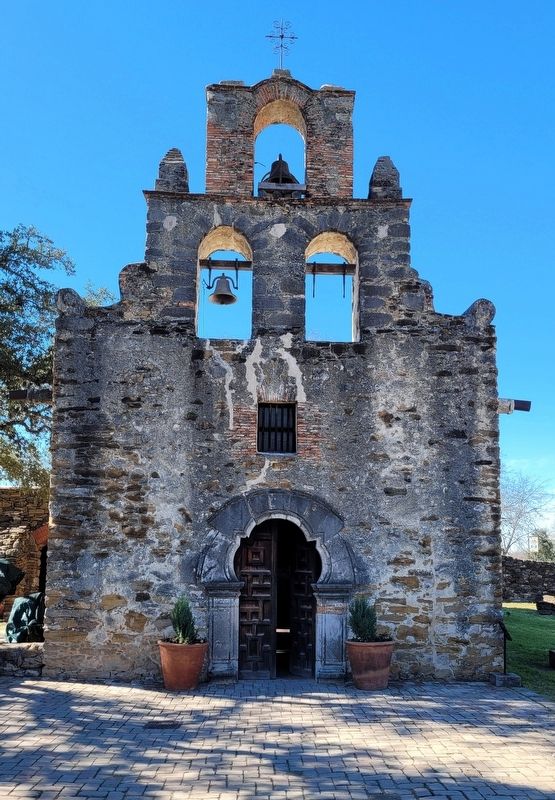Southside in San Antonio in Bexar County, Texas — The American South (West South Central)
Granary
Products of the fertile croplands and farflung ranches were safely warehoused in this food storehouse, the largest stone building in the mission complex.
Every Monday all the women come for their ration of corn... The amount...given to each woman varies... the married women are given two-thirds of a bushel of unshucked corn, and a third or a half a bushel to the Widows...and when shelled corn is available, nine quarts are given.
The Indian women frequently pester the Missionary for sweets, lard, beans, chilli, and a thousand other things.
Guidelines for a Texas Mission, 1787
The Franciscans introduced many new foods and spices such as cumin, oregano, pepper, cinnamon, saffron, garlic, and rosemary. All these were then unknown in Texas. Chilies and corn had come north from Mexion and were already staples in the local Indian diet.
melons • chilies • spices • corn • chocolate • squash • sugar • beans
Spanish:
En esta tierra semiárida, nada era tan esencial para el éxito de una misión como contar con una provisión segura de viveres. La promesa de asilo y de comidas regulares atrjó a los indígenas que vivian cerca de Espada - arcahomos, malahuitos, pacaos y tacames - a formar parte de la comunidad nueva.
Se almacenaban los productos de las tierras fértiles y las haciendas extensas seguramente en esta troje - o granero de viveres - que era el edificio de piedra más grande en el recinto de la misión.
Los Lunes de todas las semanas acuden todas las mugeres por la ración de mays... La cantidad de mays que a cada una se le da es diferente...se les dan cuatro almudes en masorca a las casadas, y dos y medio, o tres a las Viudas...y cuando pueda darseles desgranado se les darán dos almudes.
Las peticiones de las Yndias son frequentes importunando al Ministro por dulce, manteca, frijoles, chile, y otras mil cosas.
Instrucción para el Ministro de la Misión en la Provincia de Texas 1787
Introdujeron los franciscanos muchos alimentos nuevos y especias como comino, orégano, pimienta, canela, azafrán, ajo y romero. En Texas todos estos eran desconocidos en esta época.
Han procedido de México los chiles y el maíz y ya constituían elementos fundamentales de la dieta indígena de aquí.
sandías • chilies • especias • maíz • chocolate • calabazas • azucar • frijoles
Erected by San Antonio Missions National Historical Park.
Topics. This historical marker is listed in these topic lists: Agriculture • Churches & Religion • Forts and Castles. A significant historical year for this entry is 1787.
Location. 29° 19.06′ N, 98° 27.058′ W. Marker is in San Antonio, Texas, in Bexar County. It is in Southside. Marker is at the intersection of Espada Road and Camino Coahuilteca, on the left when traveling south on Espada Road. The marker is located at the south section of the Mission Espada grounds. Touch for map. Marker is at or near this postal address: 10040 Espada Road, San Antonio TX 78214, United States of America. Touch for directions.
Other nearby markers. At least 8 other markers are within walking distance of this marker. The Church (within shouting distance of this marker); Espada Mission (within shouting distance of this marker); Mastering New Mysteries (within shouting distance of this marker); Building Sanctuaries (within shouting distance of this marker); San Antonio Missions (within shouting distance of this marker); Defending the Faithful (about 300 feet away, measured in a direct line); Mission San Francisco de la Espada (about 400 feet away); Community Life at Mission Espada (about 700 feet away). Touch for a list and map of all markers in San Antonio.
Also see . . . Mission Espada. San Antonio Missions - World Heritage
Mission San Francisco de la Espada was the first Spanish Mission in Texas. It was founded in 1690 as San Francisco de los Tejas near present-day Nacogdoches in East Texas. It was renamed as Mission San Francisco de la Espada when it moved to San Antonio in 1731. Distinctive Spanish design features can be seen in the church doorway, bell tower, and brick archways. Espada’s ranch, Rancho de las Cabras, is 23 miles south of the Mission and had as many as 1,262 head of cattle and 4,000 sheep. Mission Espada’s acequia is the nation’s oldest in continuous use. It still uses San Antonio River water to irrigate local crops today illustrating the connection the river makes between the past and the present.(Submitted on March 7, 2023, by James Hulse of Medina, Texas.)
Credits. This page was last revised on March 7, 2023. It was originally submitted on March 6, 2023, by James Hulse of Medina, Texas. This page has been viewed 95 times since then and 32 times this year. Photos: 1, 2, 3. submitted on March 7, 2023, by James Hulse of Medina, Texas.


